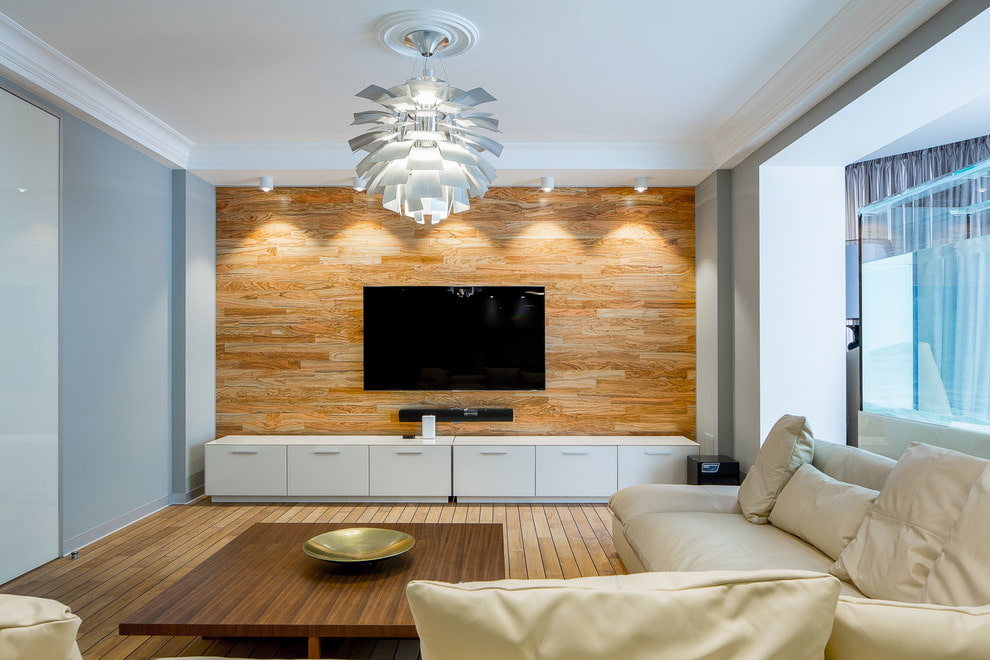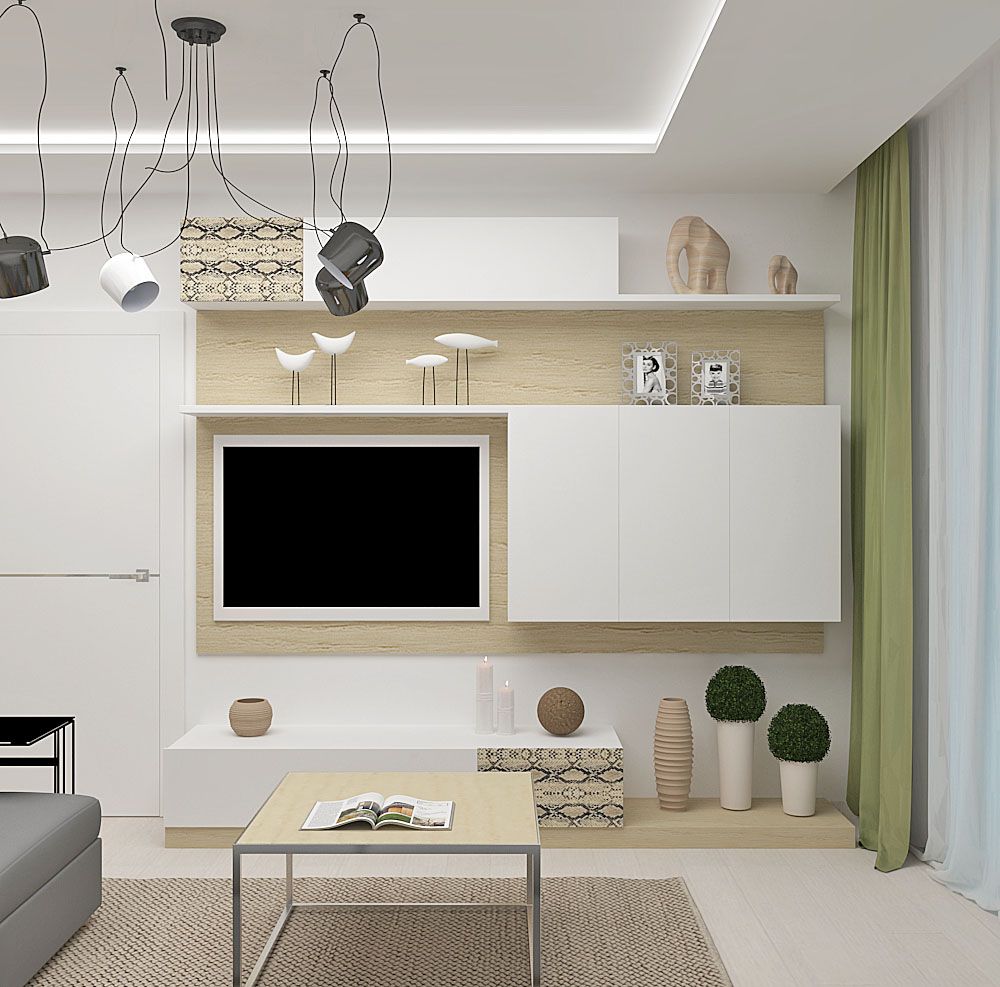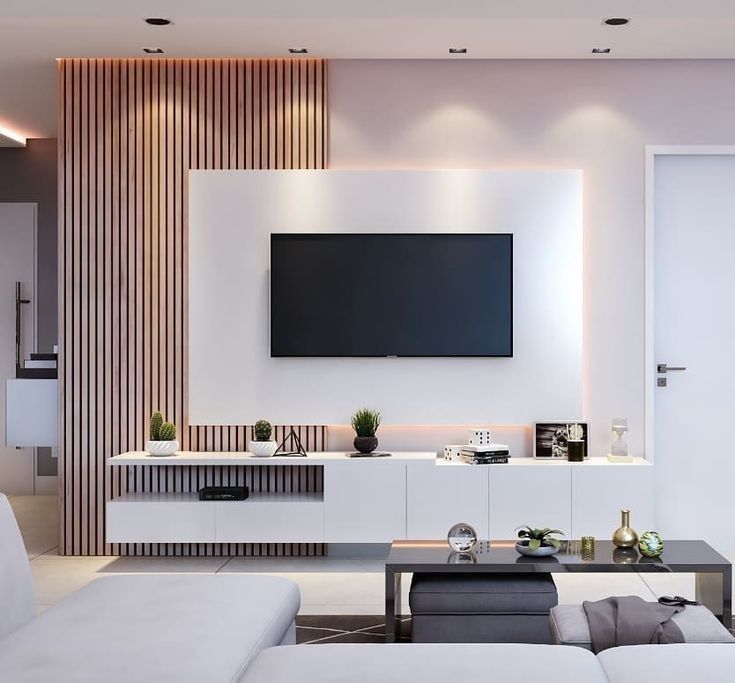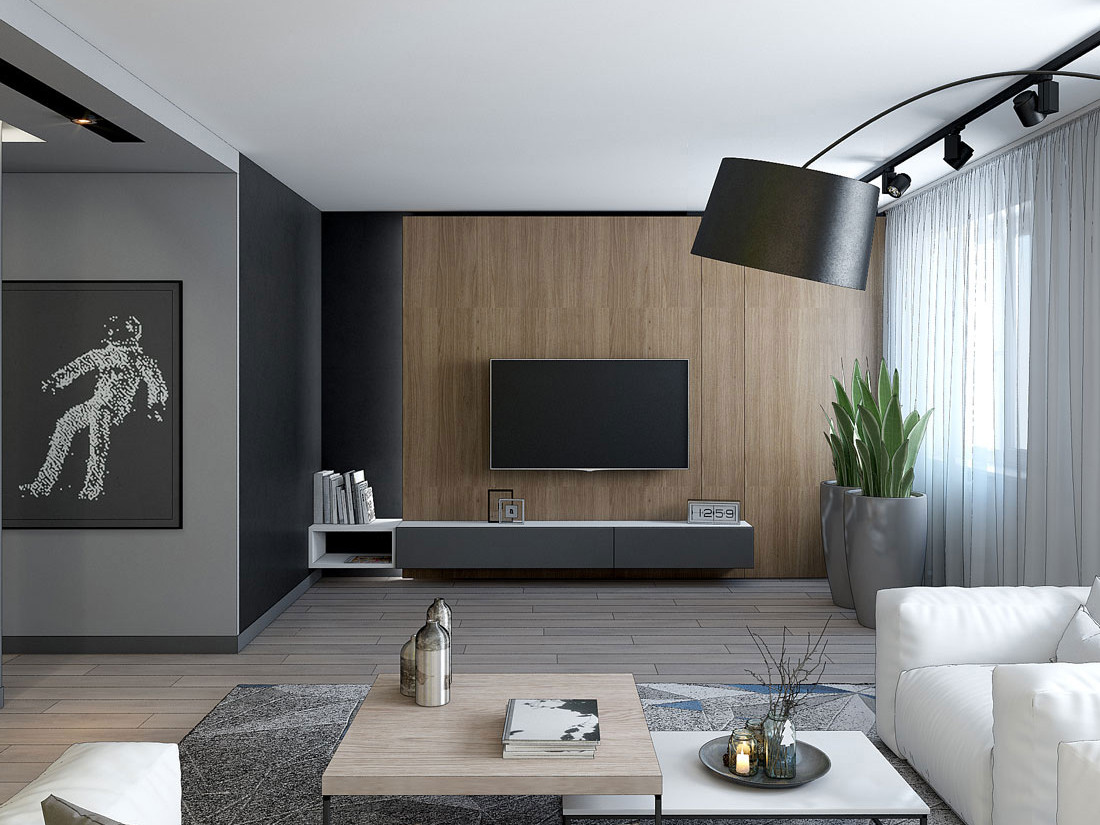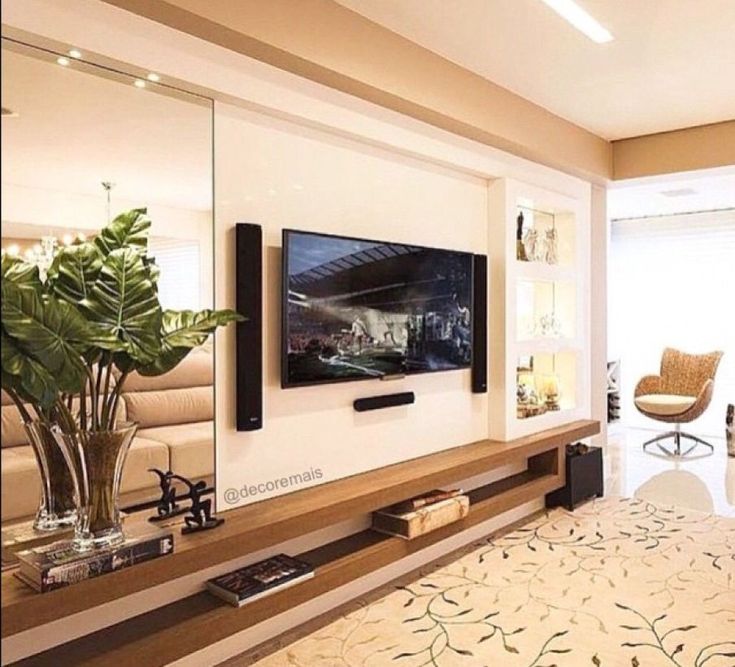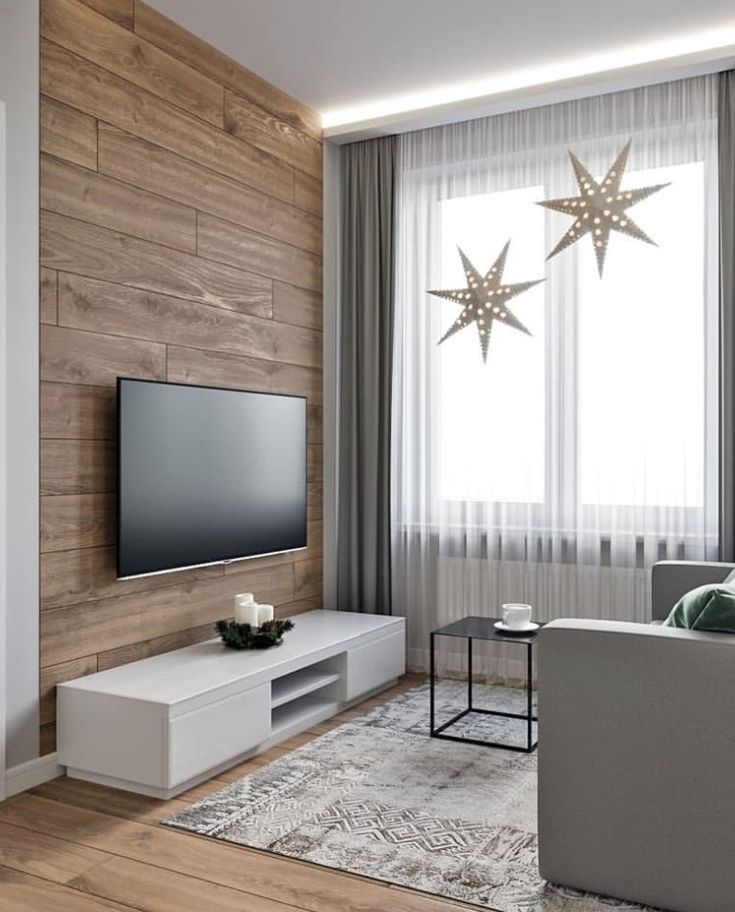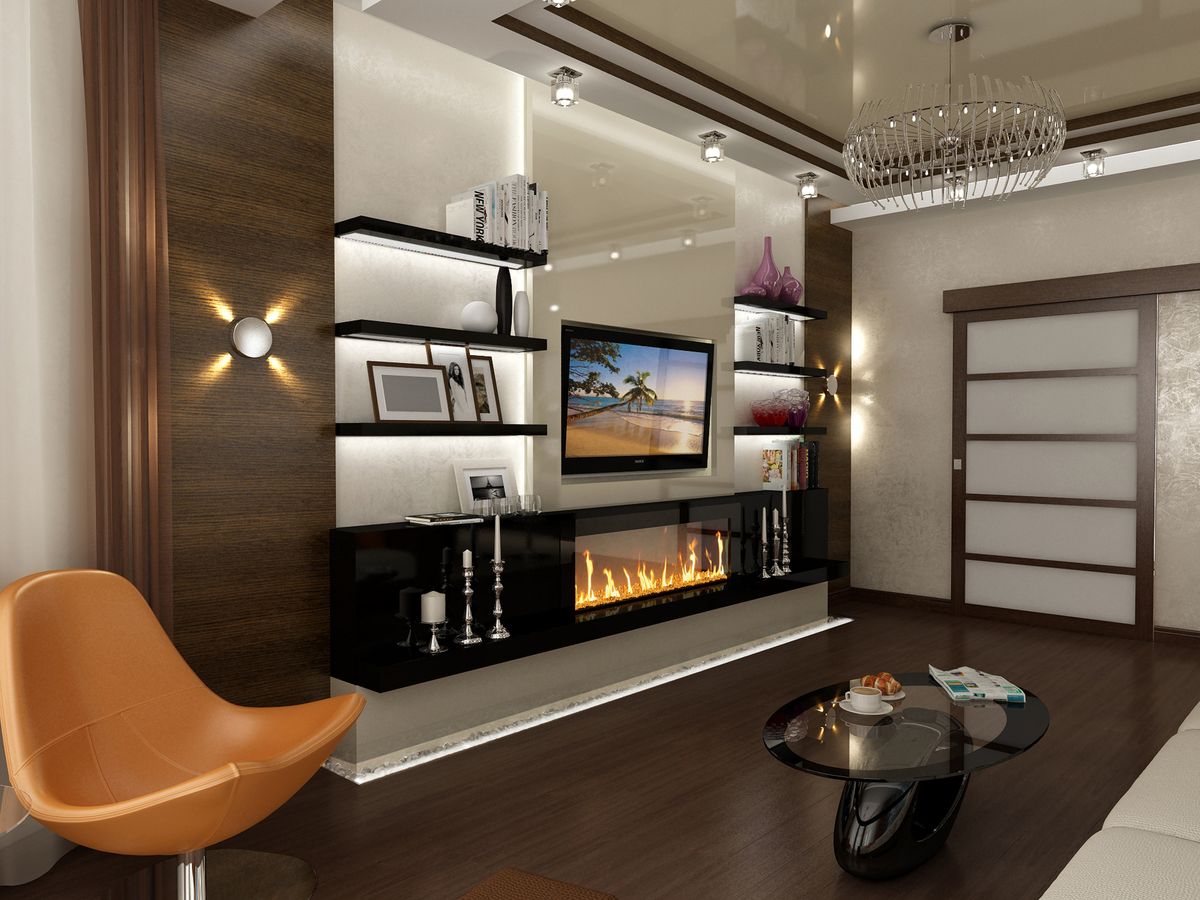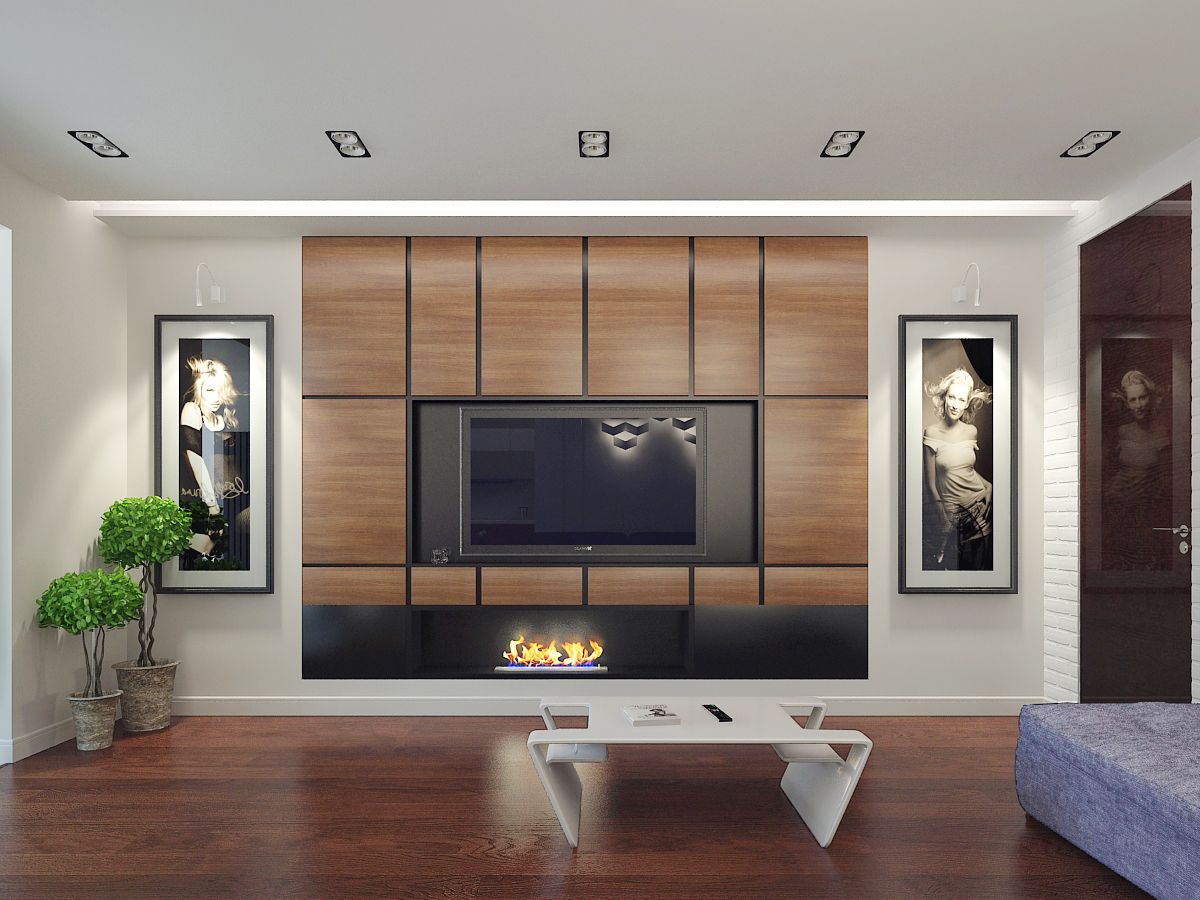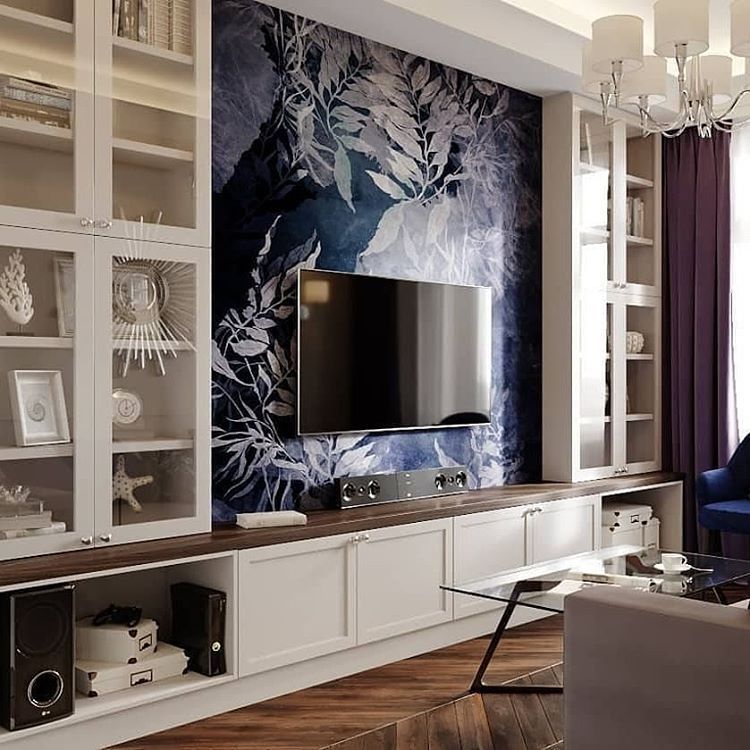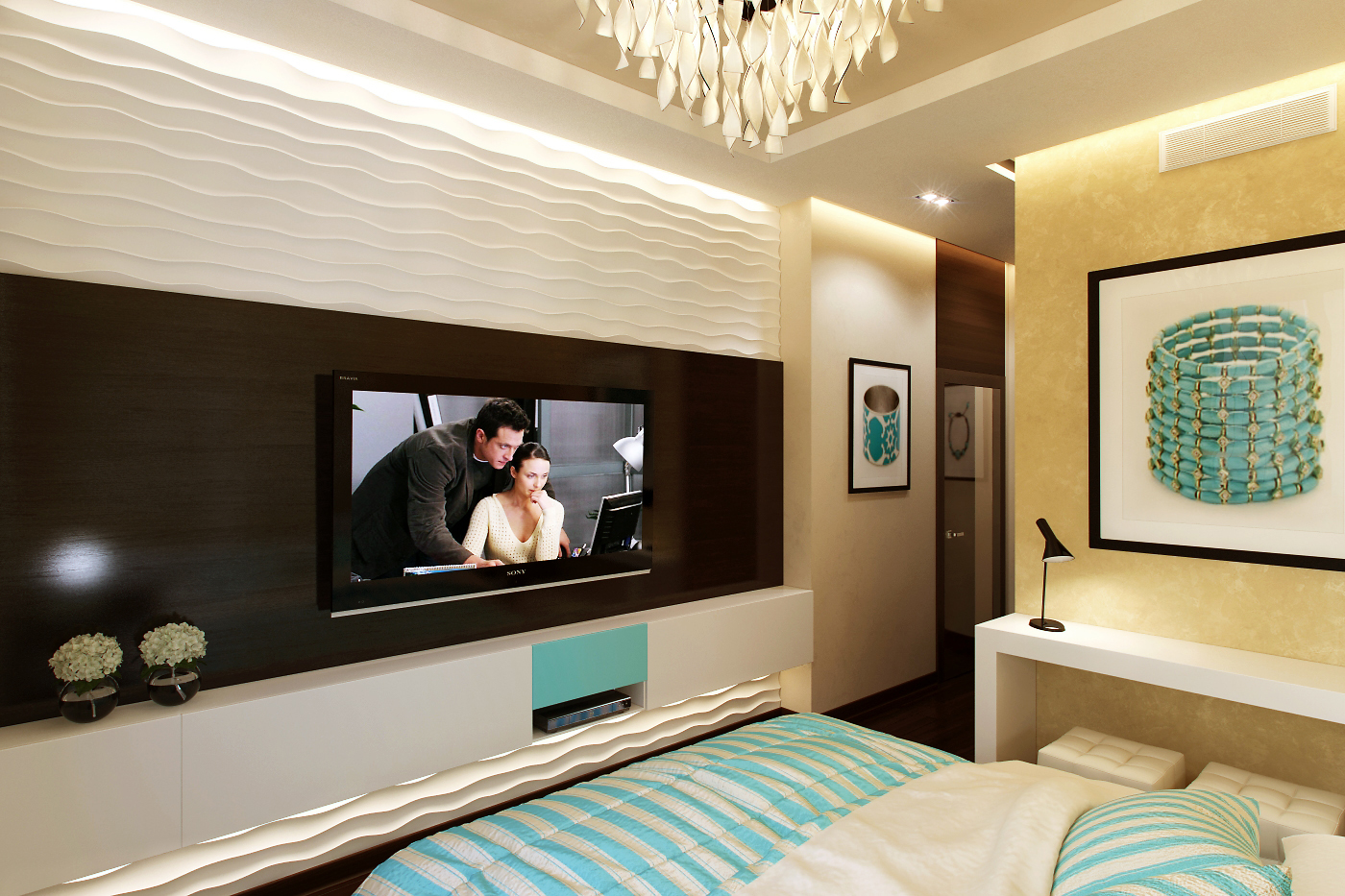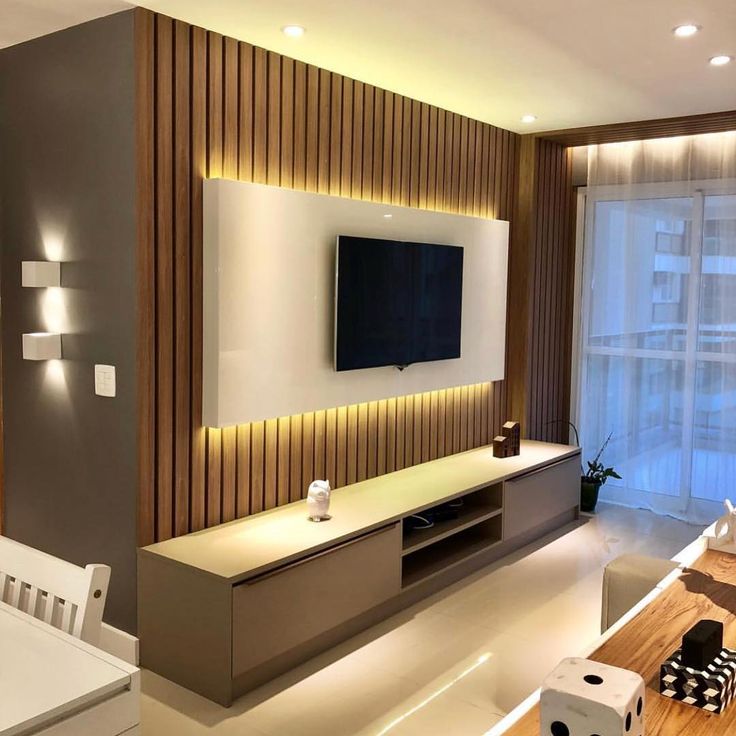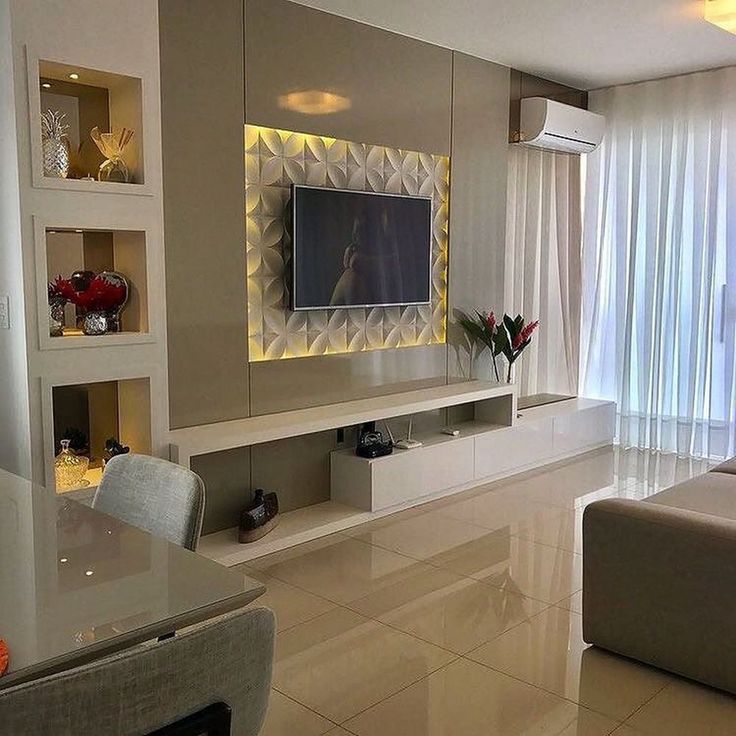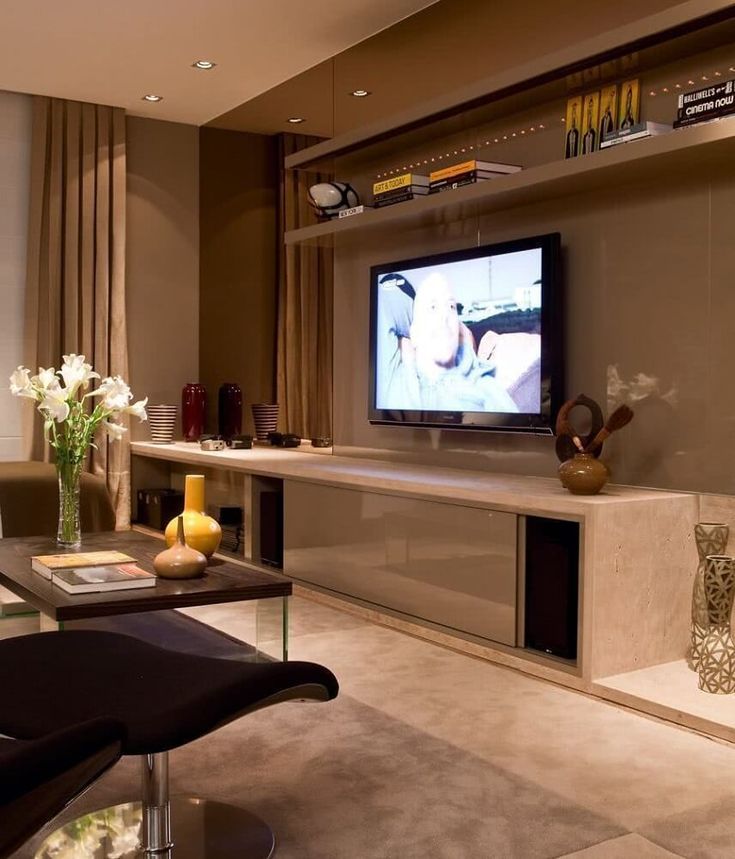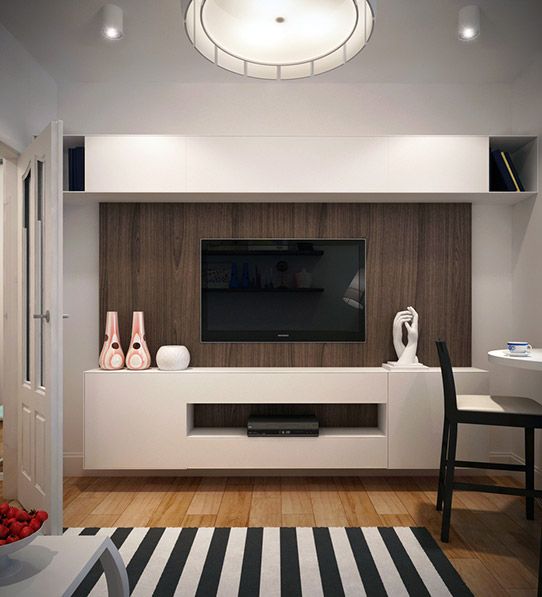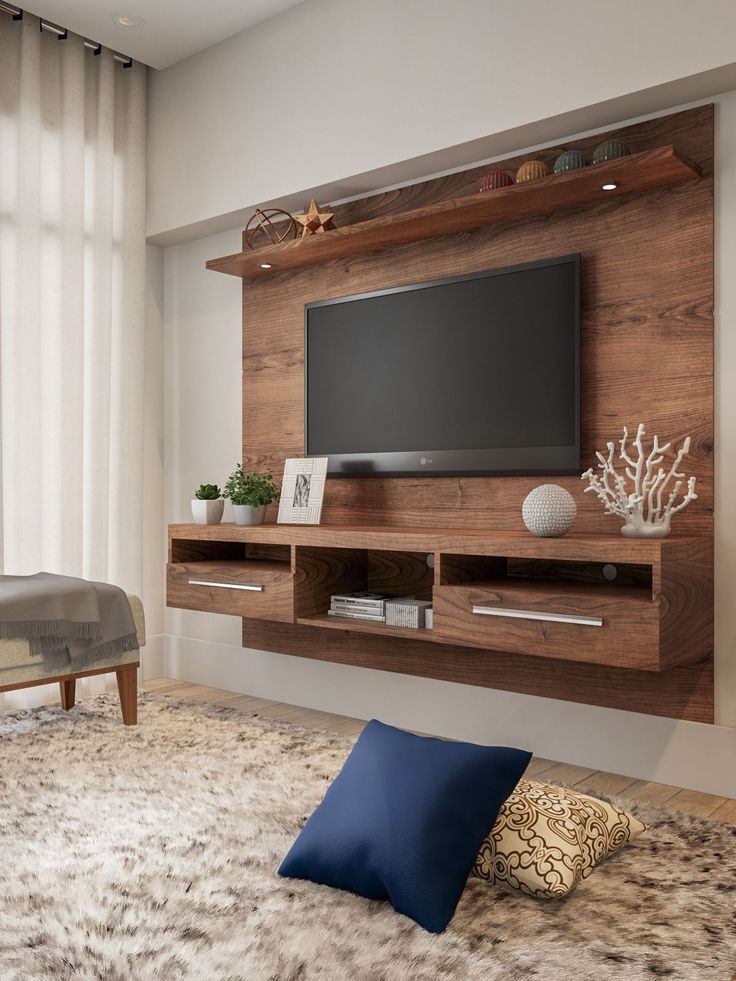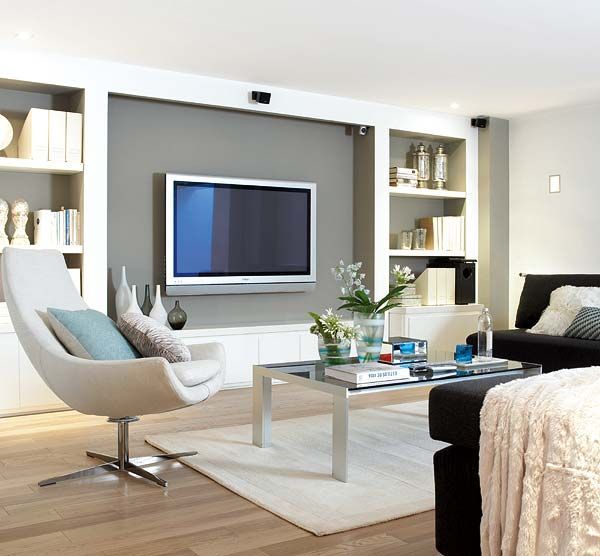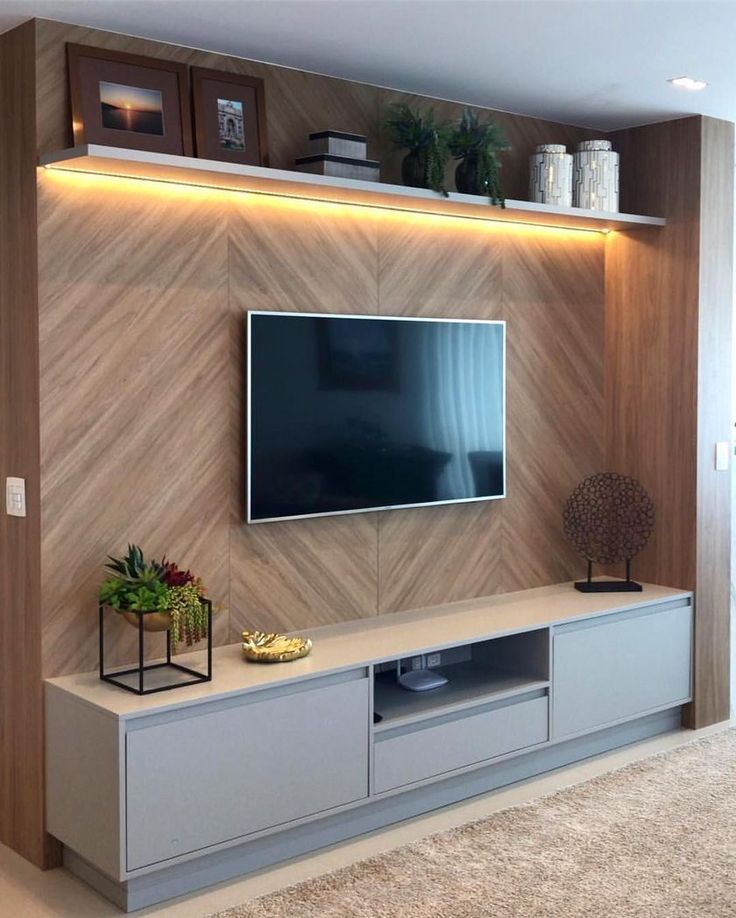Design using additional structures
Additional structures will be able to highlight the position of the TV, and also add zest to the interior of your living room. Some examples:

Wall panels. The panels do not blend in with the wall, making them stand out against the wall. Spotlights will add more beauty.
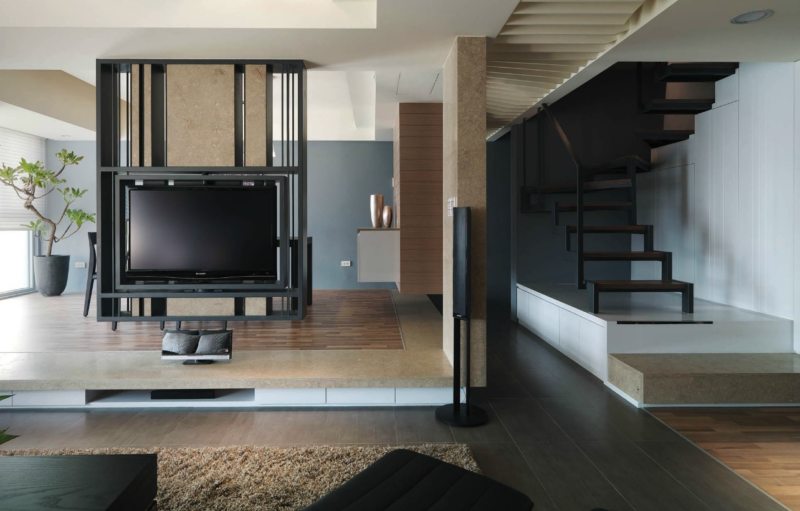
Sliding panels. They have the ability to move around. Because of this, their properties can "hide" the TV or accentuate the wall with the TV.

Rack. Some racks are equipped with a rotation and angle change device. This function will make watching programs on TV more convenient, because everyone can tune the TV to their liking.


Niche. It can simply follow the contours of the screen, and in addition, it can have several sections. Niches are often made of gypsum cardboard.

Arch. It is more often made from gypsum cardboard.

Decorating and decoration methods
With the help of special decor techniques, you can influence the overall impression of the design of the room. Interior details often shift accents and make the space more interesting.
Shelves
Shelves or racks are part of the storage system. Placing the TV on a hinged shelf or on a shelf of a rack is permissible, provided it is fully combined with the rest of the interior items.
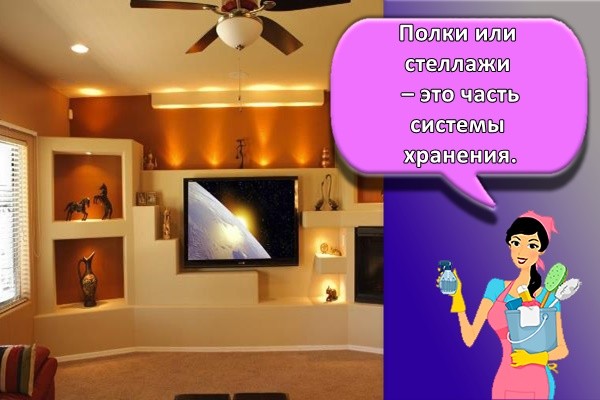
Aquarium
The aquarium is placed under the TV. Reception helps to unite accents and visually highlight the wall under the TV.
Fireplace
Hanging the TV over the fireplace requires maintaining the optimal distance between objects. The difficulty of this technique lies in the masking of the wires.
Decorative panel
On a light wall, it is permissible to place a panel. In this case, the general combination of the selected shades should be taken into account. Designers recommend choosing panels with general semantic content.
Watch
The stylistic direction is emphasized by the use of a round or rectangular clock, which is placed above the TV. The shape of the watch must comply with geometric proportions.
Lighting
The backlight of the TV helps to highlight the area. The backlight is most often placed along its entire length above the top panel or above the top corners of the monitor.
Placing the TV on the Wall
The design of the TV on the wall in the living room depends on the placement of furniture in the plane of the living room. Placement depends on many factors:
- Layout and area of the room. Only after determining the location of the TV, it is necessary to think over the further interior design;
- The optimal viewing distance is equal to at least two device diagonals;
- It is not necessary to place large plasma panels in small rooms, this choice is not rational, since the screen sizes are very inconvenient for viewing at close range.
 The TV in the frame is in harmony with the wall decoration
The TV in the frame is in harmony with the wall decoration
The TV in the living room interior, the photo of which is posted on the website, clearly shows that the monitor is an integral part of the interior of the room, on which the full design depends.
Custom interiors
Carved furniture of expensive and rare species of trees, gilding, stucco molding, heavy velvet curtains, massive chandeliers, Flemish lace - and among all this pomp of the classical style, an anthracite-black rectangle of a TV will look like a dissonance as sharp as a toothache. A half-hearted solution is to place the TV in a massive wooden frame (or made of polyurethane moldings). It is much easier to hang up the TV and disguise (hide) it. For example, a movable screen or tapestry. Or just hide the TV behind the doors of a small wall cabinet.

In a classic interior, a TV framed by a picture frame will look harmonious

TV blends in with the dark trim of the living room ledge

If you turn off the TV, a funny "blot" forms on the wall.

Black TV on the background of black furniture - and technology will not spoil the classics

The TV in the children's room is disguised as a zebra toy
Wooden elements
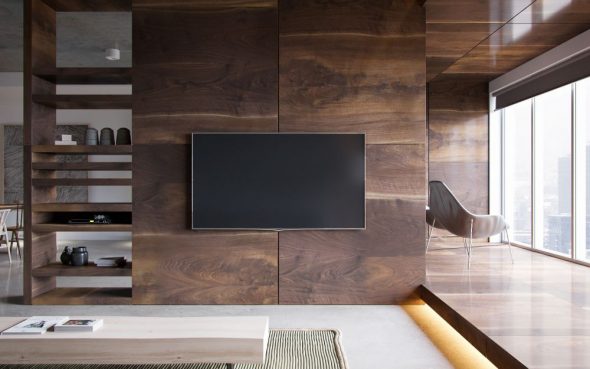
Wood always gives extra comfort to a space and makes it more expressive. Sometimes it is appropriate to cover the wall behind the TV with a parquet board or laminate.


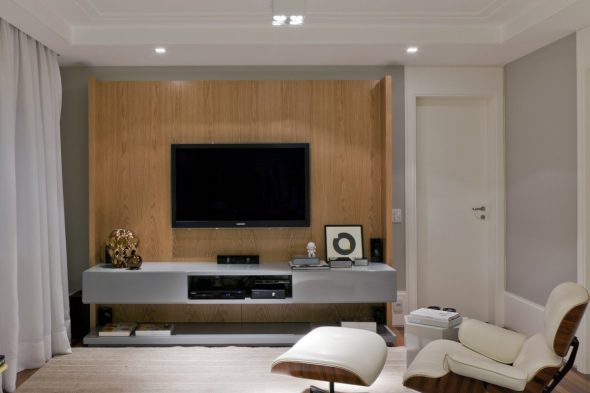
You can also use large furniture boards or panels.
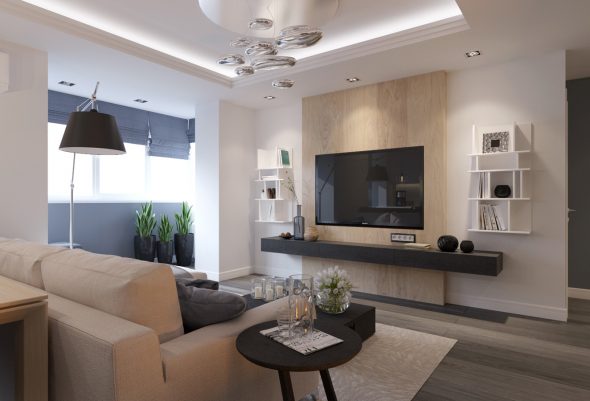

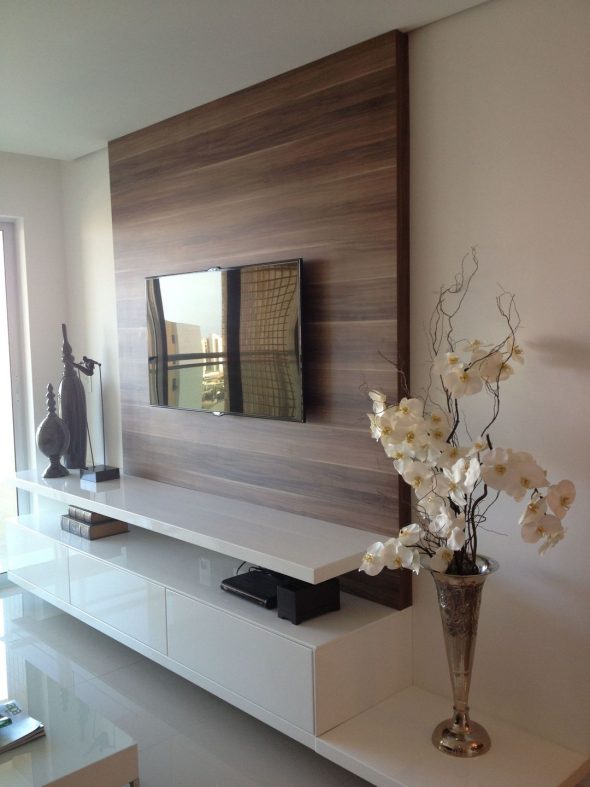
If they are made of natural wood, then it looks just gorgeous.

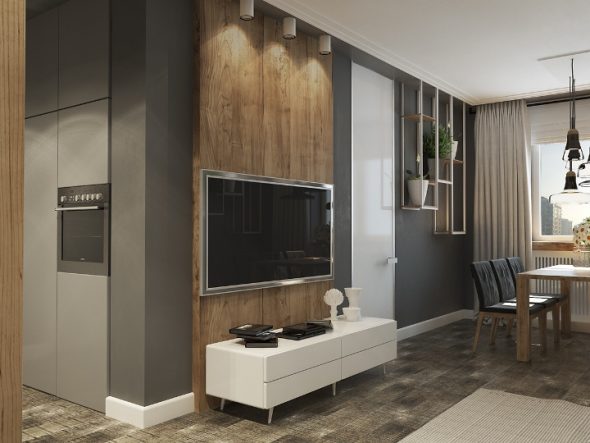
Reiki will be an elegant solution. They can be either quite thin or wider. The distance between the rows is also chosen at the discretion of the owner.

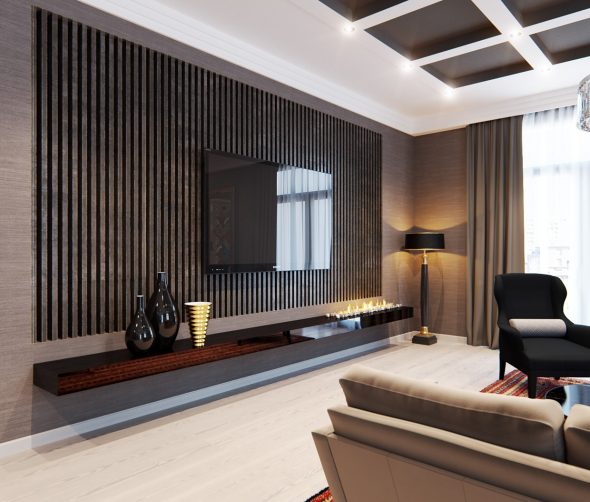
Another creative way to decorate a wall is to use wooden cubes. Small elements on the front side have a cut at an angle, due to which an interesting and rather unusual texture is formed.

We take into account different interior styles
Taking into account the design style of the room will help to make the TV an organic part of the interior.
Of course, the most natural look is a modern device in the design of minimalism, hi-tech, but this does not mean at all that a different room design should exclude TV-devices.
 A television device in a modern style looks organic
A television device in a modern style looks organic
In modern design trends, the TV can be attracted additional attention by using spotlights or by placing it in the most "honorable" place. Styles of the "majestic" direction - empire, antique, baroque, etc.
etc. - require the imperceptible presence of the TV in the interior or skillfully hiding it
Styles of the "majestic" direction - Empire, Antique, Baroque, etc. - require the imperceptible presence of the TV in the interior or skillfully hiding it.
 A beautiful screen can, if necessary, hide a modern television device
A beautiful screen can, if necessary, hide a modern television device
The TV can also be hidden between the columns, behind the sliding panels of the appropriate design, in the niches of the furniture of the chosen style.
 Carved furniture was perfect for placing a TV
Carved furniture was perfect for placing a TV
The TV, placed on an easel and covered with mini-curtains, will perfectly fit into the design of the Renaissance era.
Various ethnic styles (Chinese, Indian, Mexican, etc.) can accept this achievement of progress only in a veiled form - under the cover of screens, paper stylized panels, etc.
Some items of ethnic interior will become a kind of "haven" for the TV:
- African drums;
- Mexican hats;
- Chinese fans.
Eco style can be fully observed if you place the TV on the wall in a frame made of natural material: jute, bamboo, vine, etc.
 An interesting and original option for placing a TV on a grassy wall of eco-design
An interesting and original option for placing a TV on a grassy wall of eco-design
The classic style will be emphasized by a beautiful baguette frame in which the TV is placed.
 Beautiful baguette frame frames modern news and movie viewing device
Beautiful baguette frame frames modern news and movie viewing device
Provence and country styles make it easy to place the plasma screen on suitable pieces of furniture or shelves.
 Successful combination of TV and typical country elements
Successful combination of TV and typical country elements
Photo gallery: placement in interiors of different styles (including with a niche)
See how the designers successfully used their skills to place the TV in rooms of different styles.
LG OLED TV R flexible TV cabinet
In January 2019, LG unveiled the concept of its new roll-up OLED TV R at CES 2019. It takes less than 10 seconds to fully unfold the screen.
It was assumed that such an interior model will go on sale in the same summer - but so far it continues to be only a concept. In the fall, it was shown again, specifying the presence of 3 modes and an aspect ratio of 21: 9, instead of the standard 16: 9 format.Among the features of the model, it is worth highlighting a 4K screen with a diagonal of 65 inches (so far the only option that is expected on the market). When you press the button on the remote control, the TV form factor changes depending on the selected mode:
- Full View or full review. The TV screen is unfolded and ready to watch content.
- Line View - partial view. Allows you to use your TV as a clock or audio system.
- Zero View - "zero" angle. The matrix is completely hidden in the stand. You can use equipment in this mode only as an audio system. For music playback, the TV has a built-in front 4.2-channel audio system with a power of 100 watts.
The model is controlled using the remote control or the built-in Amazon Alexa voice assistant. To connect external media, the TV has HDMI 2.1 and USB 3.0 connectors. However, there are certain drawbacks - firstly, installation of OLED TV R is possible only on the floor, it takes up quite a lot of space in the unfolded state, and its price, according to preliminary information, is about $ 10,000.
Finishing the TV area:
You can choose the design option for the TV zone in the room from three scenarios:
- Make the TV area unremarkable, that is, the same as the rest of the interior in the room;
- Turn it into an accent design element, highlighting it brightly with other colors, materials, decorative elements;
- Completely remove the TV area from the interior, hiding the TV in a niche behind the cabinet facades.
In the first case, there is nothing difficult. It is worth continuing to implement the already chosen design project: the same material for wall decoration, the same color. Neutral tone-on-tone furniture that remains almost invisible and does not attract too much attention ...
The last option is also easy to implement, since it all comes down to the correct selection of facades for the cabinet wall, where the TV screen will be hidden.

The most interesting thing is to find solutions for decorating a TV zone, when it should become an accent spot in the interior, stand out from the rest of the design and catch the eye. In this case, the wall near which the TV is placed can be pasted over with interesting printed wallpaper, painted in a bright and bold color, and covered with decorative plaster. Tiles or natural stone finishes can be used. In loft interiors - rough brick or bleached concrete blocks. Natural wood and soft panels upholstered in fabric or leather are also a fresh and interesting design solution.
A bold move is turning the TV itself into a work of art. The black square or rectangle of the screen is not just hung on the wall, but placed in a custom-made carved baguette that frames the TV like an expensive painting. True, this option will not be appropriate in all interiors.

Advice
To install a TV, it is advisable to adhere to certain rules:
- Large-screen TVs should not be located close to the viewing area. The most optimal distance to the screen is from three to five meters, so TVs with a diagonal of about 36 inches are inappropriate in small rooms.
- The most acceptable height from the floor to the center of the screen is 70 centimeters.
- Heating radiators are not the best neighbor for TVs. It is wrong from the point of view of design and practicality to place a television device on any household appliances.
- The sun's rays or light from an artificial light source must not shine directly on the screen.
- A small gap should be left between the wall on which the device is mounted and its back panel - for ventilation and cooling of the TV (this is especially true for plasma models).
The quality of perception of a television picture depends on the placement of the device. The ideal option is to hang the TV in front of the eyes of the person who is watching the selected programs or films.
Strong walls are a guarantee of safety when installing a TV.Brickwork will withstand the largest and most massive devices, when mounted on other materials (drywall, panels, etc.), you should think in advance about measures to strengthen the place where the TV will be placed.
If there is a desire to place the TV over the fireplace, then this may entail some inconvenience when viewing, because the device will be located above the eye level of the viewers.
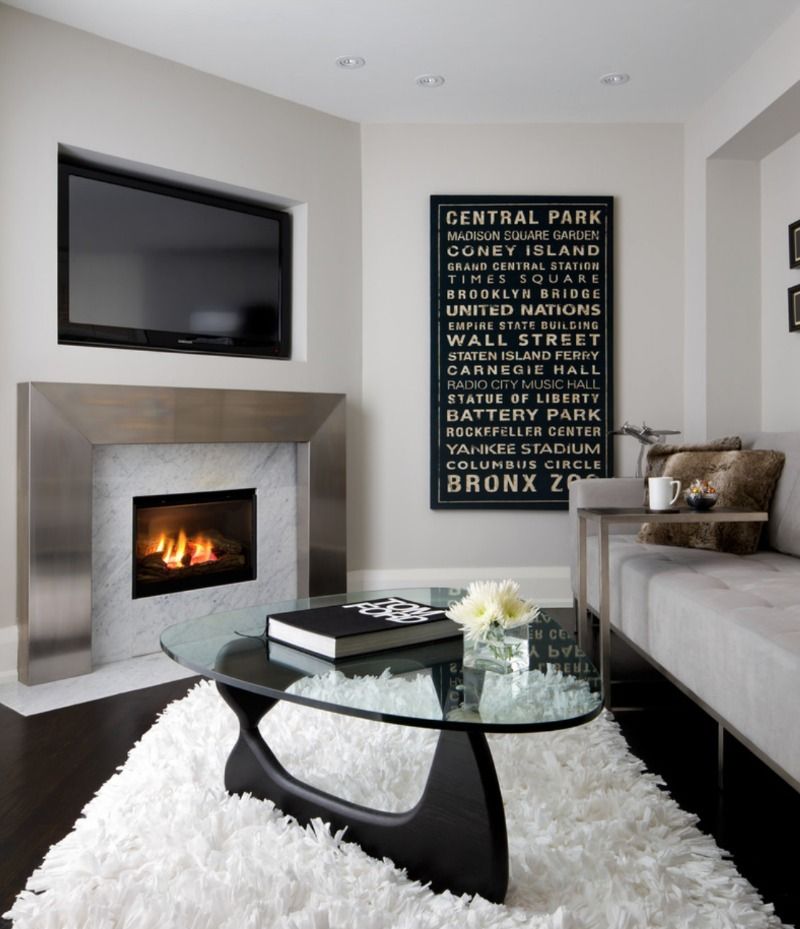 When viewing, certain inconveniences may arise.
When viewing, certain inconveniences may arise.
In a room with a fireplace, it is better to choose the option of placing the TV and fireplace on different walls, in this case none of the items will be "deprived of attention". This arrangement allows each item to be emphasized.
 This arrangement allows each item to be emphasized.
This arrangement allows each item to be emphasized.
Technical nuances
The most practical and most acceptable way to mount your TV to a wall is to use a TV bracket. This method has its advantages:
- no additional furniture needed;
- the ability to "match" any style, since the bracket is hidden behind the TV panel;
- the presence of swivel mechanisms that create additional comfort when viewing.
The disadvantages of such an attachment include the need to violate the integrity of the wall. In some cases, you have to drill or chisel the wall part to strengthen the TV.
Most modern TVs require an antenna cable connection. This creates additional inconvenience when installing a television device in the interior. Reliable, high-quality, most inconspicuous wiring will become an indicator of the high level of the designer, because any design of the room can be spoiled by hanging wires or carelessly laid cable. Therefore, it is necessary to observe the measure between the creation of favorable conditions for high-quality reproduction of the picture on the screen and the hidden wiring.
The television of a modern man is an integral and important part of his life. By placing this device correctly, you can enjoy watching your favorite movies and programs without harm to your health.
At the same time, it is important to comply with the chosen style of the entire interior so that the TV becomes an organic part of it.
Wall design and placement of the TV on it
The design of the walls in rooms can be different, the shape of the TV, its size and placement depend on it.
 Modern interior of a living room in a private house with a TV on a side table
Modern interior of a living room in a private house with a TV on a side table
The initial stage before installing the TV is planning the placement of furniture and all elements of the room interior. At this stage, you need to think over the smallest details:
- Wall color and texture;
- Convenient location of equipment;
- The least influence of external factors of influence on the TV.
The decoration of a wall with a TV can be decorated with: mirror tiles, various photo wallpapers with collages of famous paintings, vinyl stickers, panels made of artificial materials, decorative stone or bricks.
 Wall niche finished with natural wood
Wall niche finished with natural wood
The color of the wall where the plasma will be placed should not be too bright. To paint the installation site of equipment, it is rational to use classic shades: cream, chocolate, ivory, black, white.
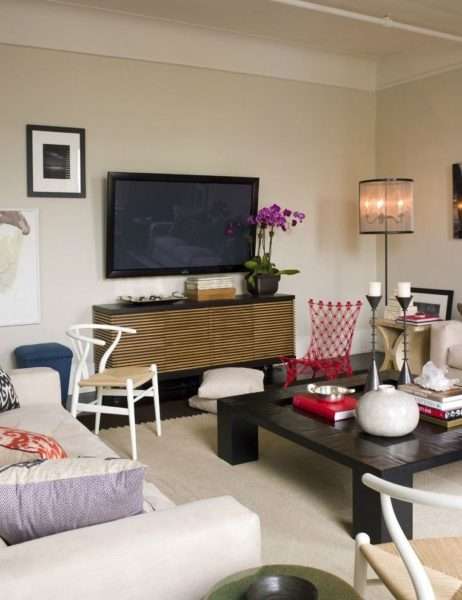 TV on the wall of the living room, painted in pastel colors
TV on the wall of the living room, painted in pastel colors
It is possible to decorate a wall with a TV in the living room over an artificial fireplace, the photo below perfectly interprets the designer's idea.
 The fireplace and the TV, placed in the living room on the same wall, but in different corners, looks just great.
The fireplace and the TV, placed in the living room on the same wall, but in different corners, looks just great.
TV-picture Samsung The Frame
Another line of products from Samsung, which also refers to interior TVs. This series received not only bright and high-quality screens, but also special interchangeable frames and even a built-in “image store” Art Store. The displays feature 100% color gamut, 4K (3840x2160) quality and HDR10 + support for optimal contrast.
The built-in light sensor automatically adjusts the colors on the display depending on the light level, and the motion sensor turns off the TV when no people are in the room.
Thanks to the removable panel, the image can be framed in walnut, white, brown and beige. Although it is imitated in this case, rather, the frame of the picture - the TV goes into the mode of the same name when it is turned off. Instead of a black screen, owners and their guests can see one of the works of art from the built-in app. The list contains more than 1200 paintings - mostly masterpieces of famous artists.
Like The Serif line, the screens of The Frame models are resistant to fading, which allows you to use the "Picture" mode for several hours or even days in a row. And in normal use for watching TV, movies or videos, the TV from the series is capable of producing high-quality sound, for which the proprietary Quantum chip is responsible. Also, The Frame TVs feature an elegant solution that allows you to hide the wires. Instead of several cords, the model received one One Connect cable, which is easily hidden during installation.
The Frame lineup consists of 4 variants - 43, 49, 55 and 65 inches. However, on sale in Russian stores, basically, there is only one model. The cost of a 55-inch TV, capable of connecting to both Samsung and Yandex smart home systems, starts at 90,000 rubles.
Placement of wires
Thinking over how to place a TV in the interior of a room, do not forget that several wires will definitely go to it (in a modern TV there are three or more), which must be hidden somehow. Usually, a white plastic box, various hinged decorative structures are used for this. You can also hide the wires in the baguette.
For the same purpose, decorative panels or paintings, large indoor plants are often introduced into the design. If you have creativity, you can come up with a way to decorate the wires, for example, stick a small white "fence" on the bottom of the wall or arrange the wire in the form of a sakura twig. In the living room, you can decorate the TV as a fireplace, the stucco around which will hide the wires. The main thing is not to violate the stylistic unity of the interior with your design delights.
Color spectrum
The TV case mainly has standard colors:
- black;
- white;
- gray;
- silvery;
- dairy.
The shade of the TV frame should fit into the composition of the zone as organically as possible. It can be a complete harmony of color in a monochrome ensemble of similar tones. Or a contrasting catchy solution. Designers believe that these two methods of combining shades are the main ones, everything else is a play of colors based on them.
The contrast between the TV and the zone should be correct. For example, a black TV panel will work well with a brick finish, while a silver TV panel will not work at all.
Warm beige and milk tones of the frame will not fit well into the high-tech style interior.
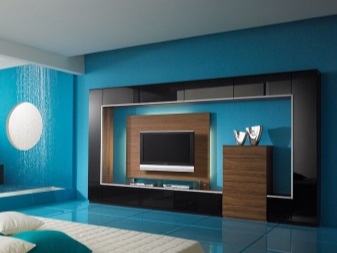



"Hide"
And yet, there are times when you cannot do without hiding the TV - it does not match the interior of the room so much, or you want to protect young children from uncontrolled viewing. Well, this is not difficult to do. Watching and copying design chips!
We place the equipment right under the ceiling! This is especially convenient for those who like to relax while watching a TV series while lying in bed. One press of the button - and it is "pulled" back into the niche.
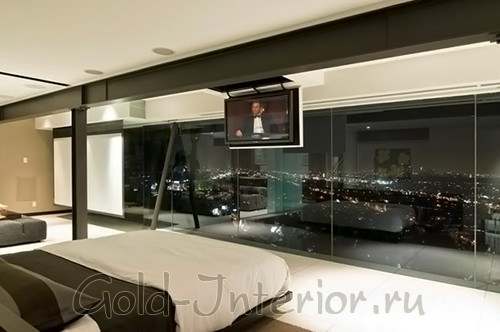

In a room that embodies the style of the "Belle Epoque", the TV will be out of place. The panel will overshadow elegant furniture and fragile vases - for the interior it will be a rude intrusion. But there is a solution - a niche hidden in the wall where the TV is mounted. Sliding or opening doors allow you to leave the old look intact.
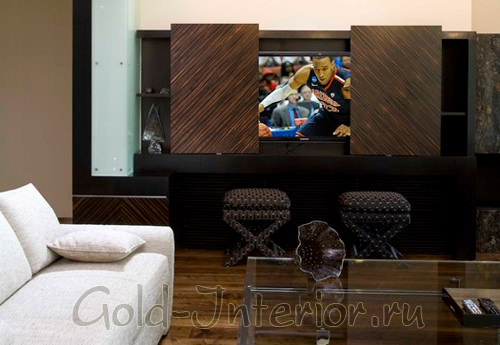
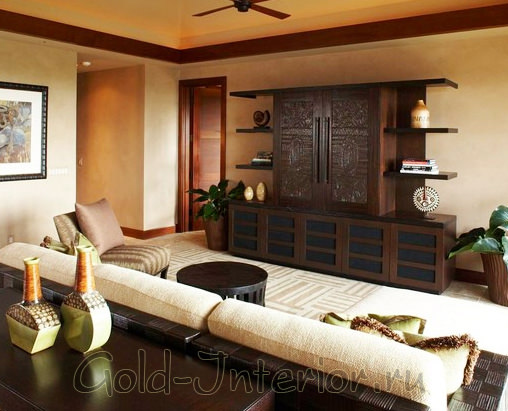
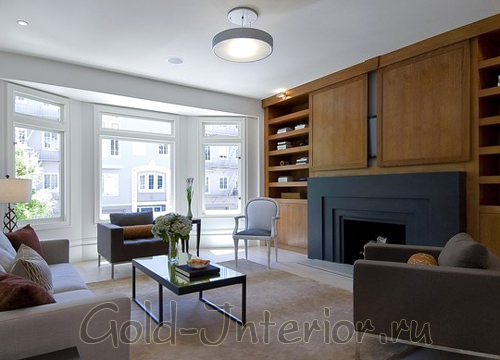
If there is only one free wall in the room.And you want to place both the big picture and the flat screen, which take up more than half of the surface separately. And what should be done? There is a solution! You can hide the TV behind the "moving away art canvas".
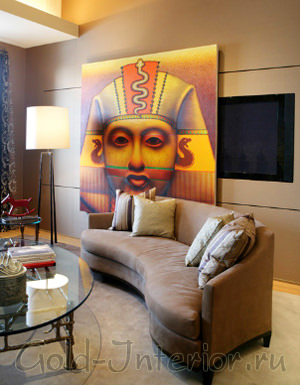
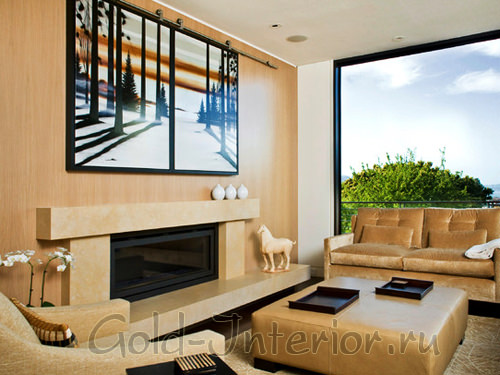
The TV is often adjacent to the fireplace, and this has a negative effect on the decor of the latter. In this case, the designers propose to close the screen with doors that look like shutters - and the authenticity of the masonry or ceramic tiles is not compromised.


How can you fit a TV into the interior
Modern television has ceased to perform functions that involved organizing the leisure of the whole family. The TV has become part of the interior. News and TV shows can be watched on a tablet or laptop, photos and music in high quality are reproduced by smartphones.
The TV is used for its intended purpose in several cases:
- when it is part of a home theater, and selected films are gathered around it to watch together;
- when it is in the kitchen and turns on as a background when preparing food or at a quick meal.
As part of a storage system
The storage system in the modern interior of the living room or bedroom is called racks, open or closed consoles, cabinets with hinged modular shelves. Reception of placement has been preserved since Soviet times, when the TV occupied the central place in the room, it was located on one of the pedestals of the "wall", consisting of bulky cabinets, a secretaire and a pantry. In a modern concept, the storage system is a lightweight design with built-in modules and consoles.
Accent wall
Allocating an area for TV is a modern design technique. It is created using several techniques:
- wall decoration with a TV in a contrasting color;
- creating a wall with a different texture;
- using decor elements to highlight the wall.
Niche panel
A common technique for a living room, bedroom or kitchen in a multi-storey building involves creating a special niche. The place for the TV area is designed using drywall. The niche allows the flat panel to be positioned unhindered and the wires to be disguised.
Above the fireplace
The TV viewing area is often located above the fireplace. In this case, we are talking about an electric fireplace, which occupies one of the main places in the interior of the room. The technique of combining two significant objects contributes to the selection of the selected area and implies the absence of accents in other parts of this room.

Disguised
This technique requires additional costs to create a special system for masking the panel. Basic camouflage options with additional elements:
- sliding door;
- reclining shelf;
- opening cabinet doors.
As an element of decor
The TV can become one of the decorative elements. This means that the panel is placed in accordance with the decor of the wall on which it is mounted:
- a dark panel is often made as a contrasting area on a light wall to highlight the TV area;
- plasma is made a full-fledged element of a section on the wall created with the help of glass, paint or textured material.
How not to do it
Analysis of numerous design solutions has identified options that make the interior overwhelmed or too empty.
In addition, some options pay attention to the TV, but do not provide for the ability to fully use it for its intended purpose.
Frame
Using a frame to decorate a TV looks ridiculous. The picture frame for the panel is a pretentious solution, which implies the semantic highlighting of technology, setting it on a par with the objects of art.
Installation on moldings
The direct purpose of moldings is the design of the ceiling area. The use of moldings as stands for plasma or TV frame design overloads the space of the dedicated wall.This technique is more in demand when decorating walls in cafes, restaurants, public institutions of any type, where it is customary to mix styles, combine incongruous in order to make the interior memorable.

Realistic and story-driven prints
With the help of prints, separate zones are created that are designed to highlight the space and emphasize a certain idea. Ethnic patterns and animalistic subjects are popular. Placing the TV next to the print overloads the space.
Site selection criteria
Various factors will affect where exactly to place the TV in the living room. Here is a list of the most important points of TV posting:

The size of the room and its layout. In small rooms, TVs with a small diagonal are most often installed.
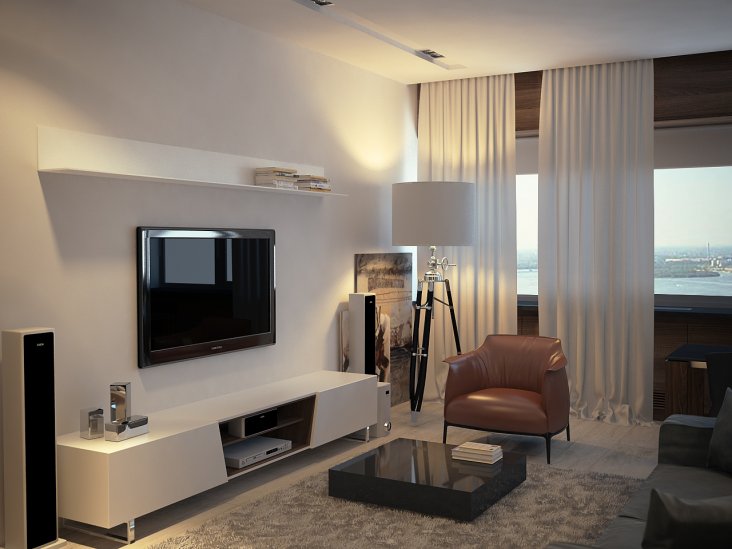
For comfort, it is necessary to provide a distance from the eyes of at least 4 diagonals
When placing, pay attention to the fact that the image can be seen from the sofa
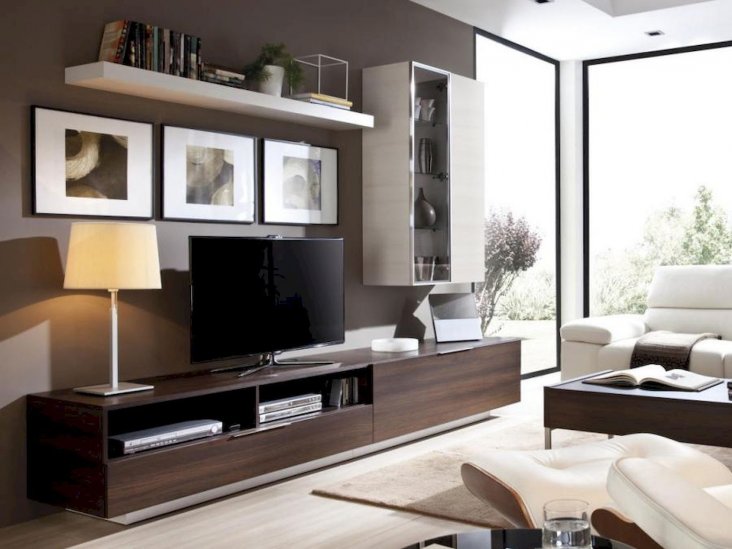


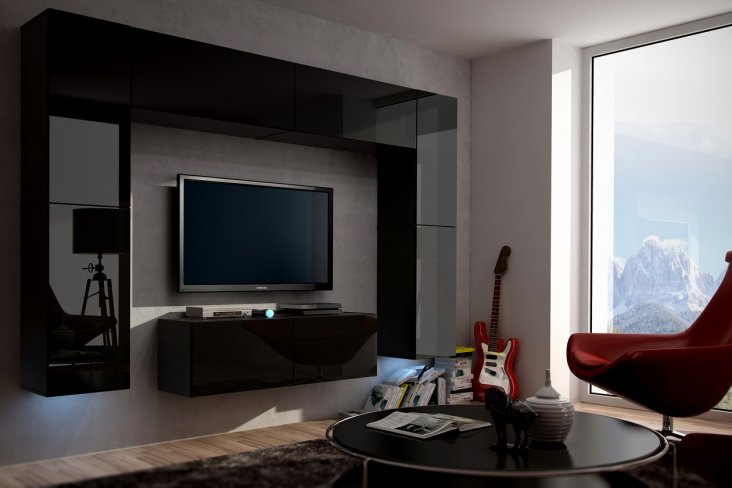


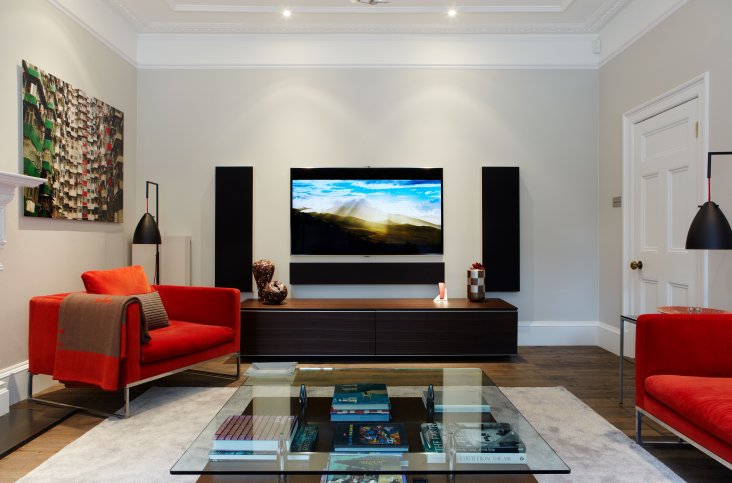


Window opening position
It is very important that the TV in the living room interior is not located opposite the window.
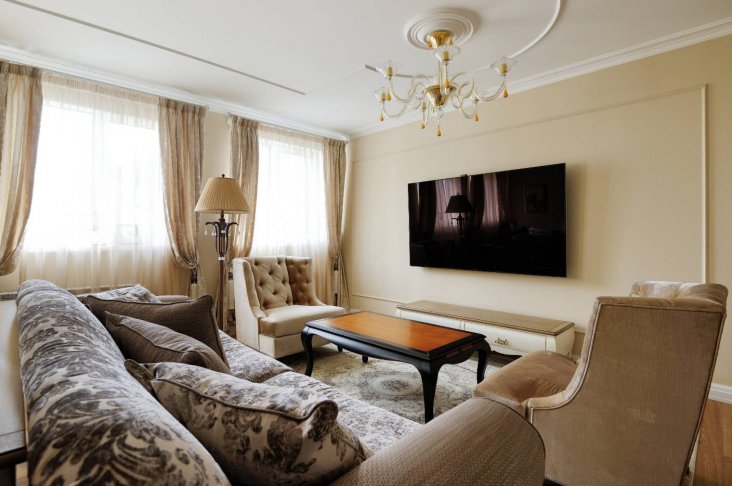

Placement rates. It is imperative to hang or install the TV in accordance with medical regulations.
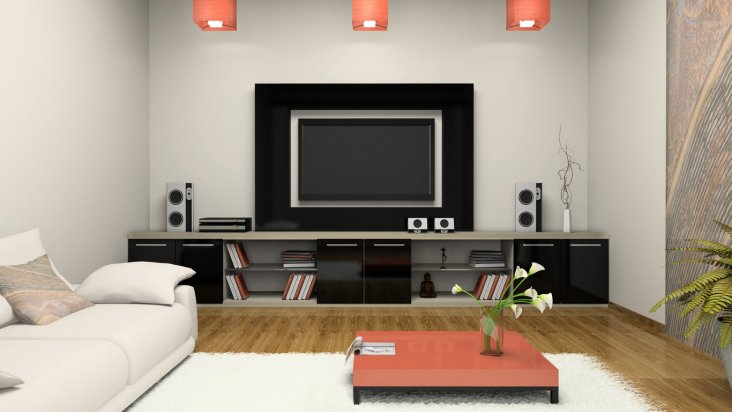
In order not to lose sight, it is necessary to move the monitor at the prescribed distance, namely at least 4 diagonals.
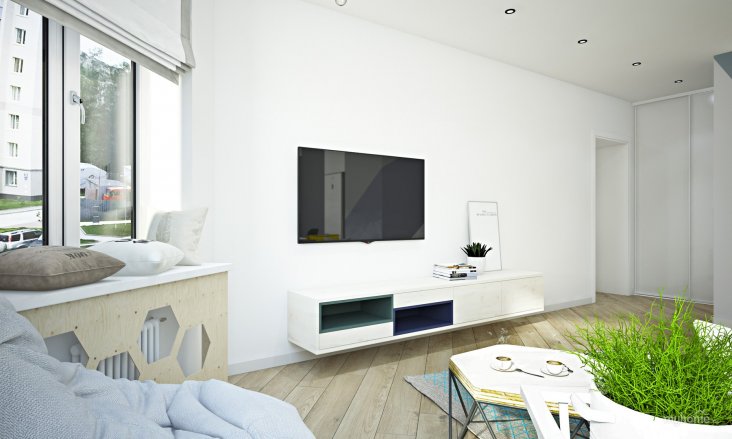
For the convenience of the position of the head and neck in height, the TV in the living room is placed at eye level.

The only exception to this will concern large diagonals, which are installed in large rooms.
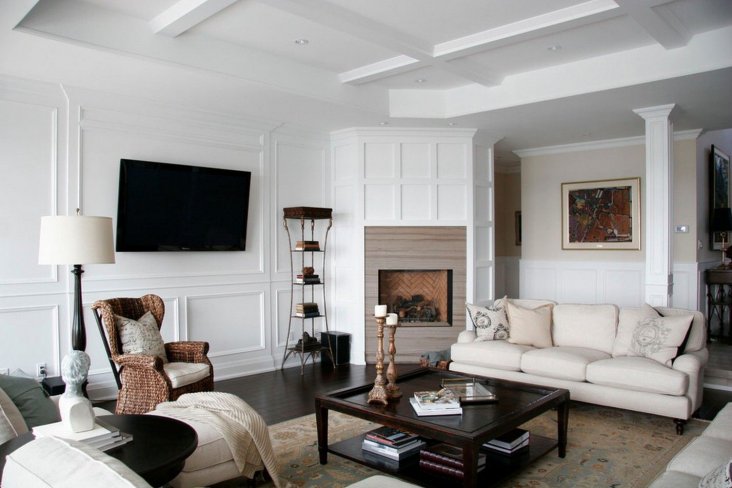
Finishing materials
Decorating a room in any style can be supplemented with an original TV area, the main thing is to choose the material and color correctly. To highlight the panel, there are a huge number of spectacular and concise ways: fresco, panel, panel made of wood, drywall, brick, in the form of a decorative fresco, panel.
Laminate and wood
Wood paneling on the wall is very much in demand in modern design. An imitated or real board gives the impression of respectability, comfort, the texture of the tree is unique. The material can be represented both by solid wood and by slabs of shavings. Quite often, laminate is used to decorate the accent zone; the same effect can be achieved with the help of slatted panels. The panel is chosen flat or with volumetric details, patterns. The horizontal position of the panel allows you to visually expand the room, vertically - to make it higher.


Wallpaper
Another way to decorate the area where the TV is hanging is with a simple wallpaper. Variations of shades, textures, ornaments - a huge variety, you can choose for every taste and style. Use monochrome or create a combination of contrasting canvas - it all depends on your taste and the overall design concept.
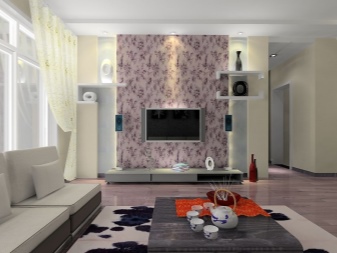

3D
Volumetric wall panels have a fairly large number of fans among designers. The interior, complemented by such details, makes a very non-trivial impression. Installation will not take much time, perfectly flat walls are not needed. Between the panel and the wall there is a place for installing a soundproofing layer, which means that the use of the TV system will be more comfortable.
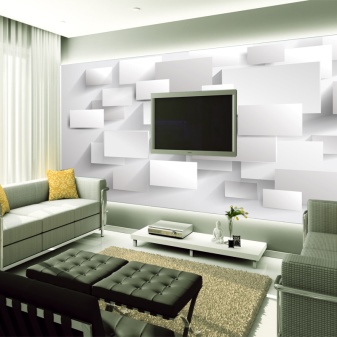
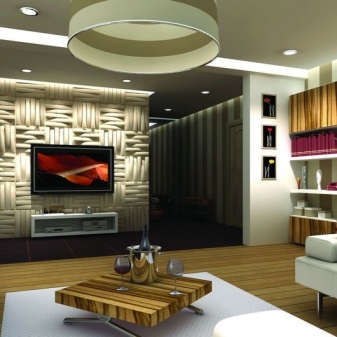
Fitostena
Quite an unusual solution, well suited for eco-design directions. Additional advantages are air humidification and purification. The irrigation system in this wall is automatic, so it won't take much time for maintenance.


Stone
First of all, the stone can be natural or imitated, the natural version is quite heavy. Most often, such variations are considered by residents of private houses. But artificial panels are optimal for decorating apartments. This design looks as comfortable and stylish as possible, although the stone is cold in appearance, it brings warm notes to the composition. The volumetric panel will hide the unevenness of the walls, if any.
A brick wall is another way to decorate a TV area. It will ideally fit into the loft style or eco-direction, rustic design solutions.The wall is not necessarily laid out from natural bricks; decorative panels made of bricks are very popular.

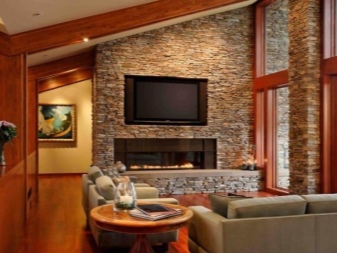
Leather
Designers often offer this material to owners who want to emphasize the respectability and status of their home. Leather is a rather noble, even aristocratic material for decoration, it will make the room expensive and stylish. You can decorate the walls with leather wallpaper or special panels. It is optimal to arrange the selected area, and not the entire wall, especially since the leather is very expensive.


Drywall
This material can be called universal, it masks irregularities and defects in the walls, it is possible to create almost any panel and structure of any shape from it. A niche can be decorated as a standard recess or as a complex structure of shelves and portals. Backlighting by the type of LEDs looks especially impressive here. Such niches look very dignified and add volumetric details to the interior. If the room is not too large, consider a corner niche - it is more economical in terms of space use.
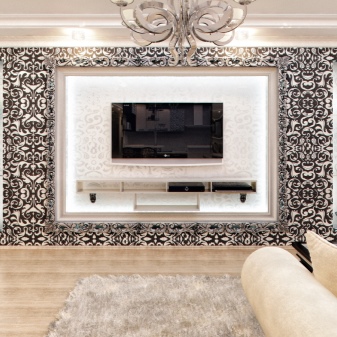

"Highlight"
Interior TVs tend to take the lead, so don't place them next to items that prioritize appearance. For example, aquariums in the interior are usually equipped with delicate lighting, and sparkling plasma will kill all their charm. Therefore, think about how to spread objects in different angles. By the way, you can select a special corner for watching TV, and this is not as difficult as it seems.
The photo below clearly shows how the empty space under the stairs is used. Upright counter, matching the wall decoration, fluffy carpet and a couple of ottomans. Fill white to avoid distorting colors and your little home cinema is ready.

Avid moviegoers don't need to be told how much the size of the screen affects the perception of the film. If you decide to get a really large plasma, it is wise to mount it on a special rack. It looks like a narrow wall that does not reach the ceiling, at the end of which are hidden bookshelves.
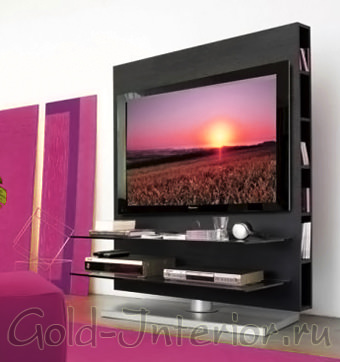
So it turns out that the TV in your apartment can be a source of inspiration in itself. Many elegant solutions will make it a sonorous accent and create an atmosphere of home around, returning to the good old tradition of spending free time with relatives.

